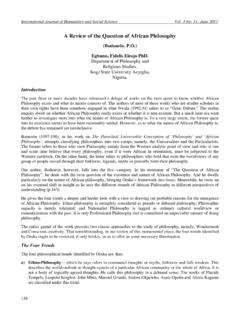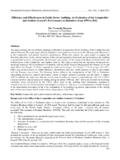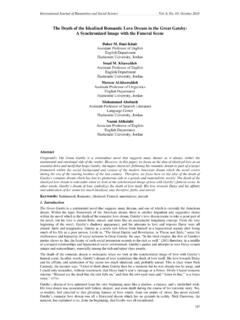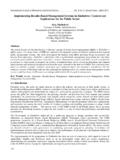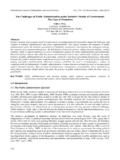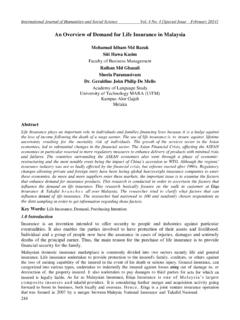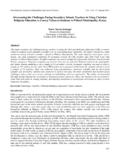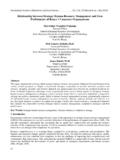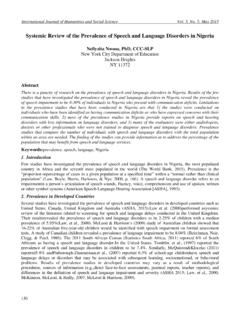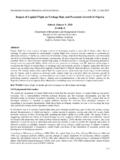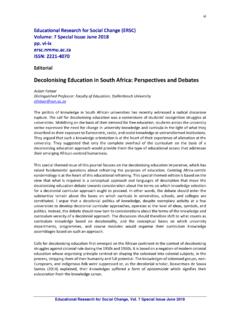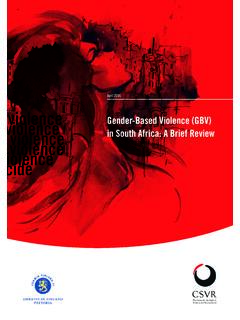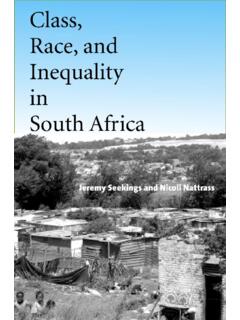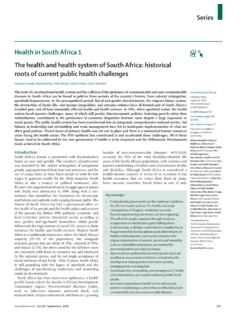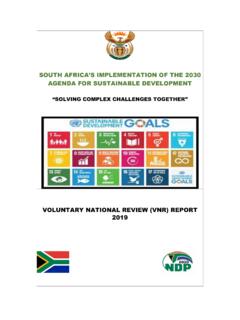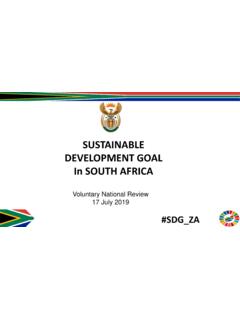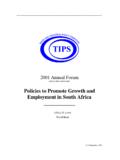Transcription of Post-apartheid South Africa and Patterns of Violence in J ...
1 International Journal of Humanities and Social Science Vol. 4, No. 8; June 2014 155 Post-apartheid South Africa and Patterns of Violence in Coetzee s Disgrace and Phaswane Mpe s Welcome to Our Hillbrow Dr. Gilbert Tarka Fai Senior Lecturer, Department of English Faculty of Letters and Social Sciences The University of Maroua Cameroon 55 Maroua Abstract Coetzee and Phaswane Mpe are among the first South African writers to bring global attention to the condition of South Africa after apartheid . In Disgrace and Welcome to Our Hillbrow, the two writers highlight the overwhelming internal pressures exerted on the new South African society by centuries of apartheid and the wider legacy of colonialism, just as they explore the volatile explosive history of the Post-apartheid era wherein total anarchy has replaced the old oppressive racist forces. The objective of this paper is to demonstrate that Coetzee and Phaswane Mpe in Disgrace and Welcome to Our Hillbrow respectively try to rectify the popular misconception of a Post-apartheid South African nation as an Eldorado or sanctuary as implied by the new dispensation of 1994.
2 This is understandable from the opinions of Ernest Renan (1990), Benedict Anderson (1983), Kevin Harrison, Tony Boyd and Seton-Watson (2003) about the nation as a perception that is more imaginary than real. In this regard, the prospect of a new South African nation after the end of apartheid would be more of a vision than a fact. Therefore, the frustrations of Coetzee and Mpe s characters manifested through different forms of Violence result from their misconstrued dreams and expectations. Merton s Strain theory (2002) also clearly points out that people brought up in a society that predisposes them to various forms of strain whether political, economic, social or psychological leave them with no option but to embrace a subculture of Violence . Coetzee and Mpe consequently view Post-apartheid Violence in South Africa not only as a result of political shortcomings but also of historical, economic, social, geographical and global circumstances since political change alone cannot magically transform the plight of a country caught in the chaotic aftermath of centuries of racial oppression.
3 The study concludes that for Coetzee and Mpe, the hope of a Post-apartheid South Africa that is free, just and prosperous lies in a gradual ensemble of efforts furnished by both South African and non- South African citizens in a global context because any egocentric or precipitated drive for instantaneous solutions only generates Violence as demonstrated by the characters in the novels under study. Keywords: apartheid , Post-apartheid , disillusionment, Violence , effort, globalisation, hope Introduction Just as Coetzee was amongst the major creative writers that played a major role in bringing apartheid to global attention, he and Phaswane Mpe are also amongst the first creative writers to bring world attention to the condition of South Africa after apartheid . What distinguishes Post-apartheid literature from apartheid literature is primarily its thematic focus. Although race is a current in the works of this category, Post-apartheid literature foregrounds the themes of poverty, assault, rape, bloodshed, xenophobia, homosexuality and the AIDS epidemic amongst others.
4 Coetzee and Mpe in Disgrace and Hillbrow respectively interpret escalated Violence in Post-apartheid South Africa not as a strange phenomenon but a logical maturation of the pressures of long years of racial segregation as well as the precipitated expectations of the post apartheid era. Narrated with austere clarity and brutal honesty mostly from the consciousness of major characters (which allows readers access not only to spoken words but also to unspoken thoughts) Coetzee and Mpe employ a complex scheme involving constructed narratives and the insertion of phrases from other languages, painting a frightening picture of Post-apartheid South Africa while at the same time subtly suggesting alternative scales of values. Center for Promoting Ideas, USA 156 Post-apartheid South Africa and the Vestiges of apartheid apartheid was a system of racial segregation enforced through legislation by the National Party (NP) government which was the ruling party of South Africa from 1948-1994 under whose rule the majority black inhabitants of South Africa were curtailed and Afrikaner minority rule was maintained.
5 Racial segregation in South Africa began in colonial times under Dutch and British rule. However, apartheid as an official policy was introduced following the 1948 general elections. New legislation classified inhabitants into separate racial groups and residential areas were segregated sometimes by means of forced removals. Non-white political representation was completely abolished in 1970 and black people were deprived of their citizenship. Through a series of Acts and laws, the government segregated education, medical care, beaches, public services, and provided black people with services inferior to those of white people. apartheid sparked internal resistance and Violence . Since the 1950s a series of popular uprisings and protests met with the banning of opposition and imprisoning of anti- apartheid leaders. As unrest spread, became more effective and militarized, state institutions responded with repression and Violence .
6 Mounting opposition, Violence and international isolation forced President Frederik Willem de Klerk in 1990 to begin negotiations to end apartheid culminating in the multi-racial democratic elections of 1994 which were won by the African National Congress (ANC) under Nelson Mandela. Although this event officially marked the end of apartheid , its vestiges still shape South African politics and society today. Coetzee s Disgrace and Mpe s Hillbrow grapple with the past and present South Africa but also subtly make projections into the future. Stated differently, the novels address the nation s apartheid and Post-apartheid political and social contexts in terms of race, class and work divisions as well as the new monsters that are gradually getting revealed with every passing page: poverty, love, seduction, promiscuity, rape, betrayal, suicide, xenophobia, urban Violence , witchcraft, scenarios of illegal drugs, the spreading of AIDS and the devastating consequences of gossip.
7 Disgrace and Hillbrow are novels about a litany of Violence perpetuated by both white and black South Africans between and within themselves but also against foreigners. It must be recalled that South Africa has a long history of Violence . According to Gary Kynock (2000): The failure of the colonial state to control urban townships and informal settlements and to provide effective civil policing created the space and incentive for the emergence of various criminals and vigilante groups that proliferated during the decades of apartheid . (2) What Gary Knock stresses above is that criminal Violence in South Africa proliferated in response to the policies of segregation that were passed by apartheid . Gangsters arose in black townships to challenge the system by openly denying work and opting to make quick money through crime and Violence . Violence in South African major cities is a forceful means by the marginalised to reclaim stake in the economy and register subjectivity in a society that has denied their existence.
8 This is supported by the Strain theory purported by Merton about Violence as a culture that comes as a result of people who have either been exposed to it for a long time or have been offered no other alternative to express their grievances. Violence then becomes a vent for the expression of their anger and frustrations against rampaging injustice. Although criminal and nationalist Violence escalated mostly during the 1980s and 1990s when political parties particularly the ANC encouraged various forms of Violence so as to render the apartheid state ungovernable, its germs had been engrained in the social fabric of South African society. Jonny Steinberg s (2004) invaluable survey of criminal Violence in South Africa in his book The Number reveals that criminal Violence was part of South African urban society as early as the establishment of the Rand in the 19th century. Van Onselen (1982), renowned academic and social historian has also, in his studies of the social and economic history of the Witwatersrand, traced the emergence of social vice (particularly crime, alcoholism and prostitution) back to the period following the discovery of gold in the Johannesburg area in 1886.
9 The demand for male labor on the Rand attracted a huge influx of prostitutes, pimps, gamblers and other undesirable elements from all over the world. Perhaps inevitably , argues, Van Onselen, prostitutes and brothels attracted a huge number of petty criminals and gamblers to the city centre where they constituted something of a nuisance (104). Disgrace and Hillbrow as earlier said, are novels set in Post-apartheid South Africa and grapple amongst other things with the vestiges of apartheid (particularly Violence ) that continue to linger into the present life of South Africa . Disgrace tells the story of David Lurie, a twice divorced, 52-year-old professor of communications and Romantic Poetry at Cape Technical University. International Journal of Humanities and Social Science Vol. 4, No. 8; June 2014 157 David believes he has created a comfortable, if somewhat passionless life for himself.
10 He lives within his financial and emotional means. Though his position at the university has been reduced, he teaches his classes dutifully and while age has diminished his attractiveness, weekly visits to a prostitute satisfy his sexual needs. He considers himself happy. But when David seduces one of his students, he sets in motion a chain of events that will shatter his complacency and leave him utterly disgraced. Hillbrow, simply told, is the story of Referentse and several of his close friends and family members who move to Johannesburg, precisely to Hillbrow for education or a better life but Hillbrow becomes a menacing monster of Violence , xenophobia, death, moral decay and broken dreams. The two novels depict Violence as a characteristic of life in Post-apartheid South Africa just as was in the past but Violence unleashed in new ways between and among the different peoples that make up the present South Africa .
